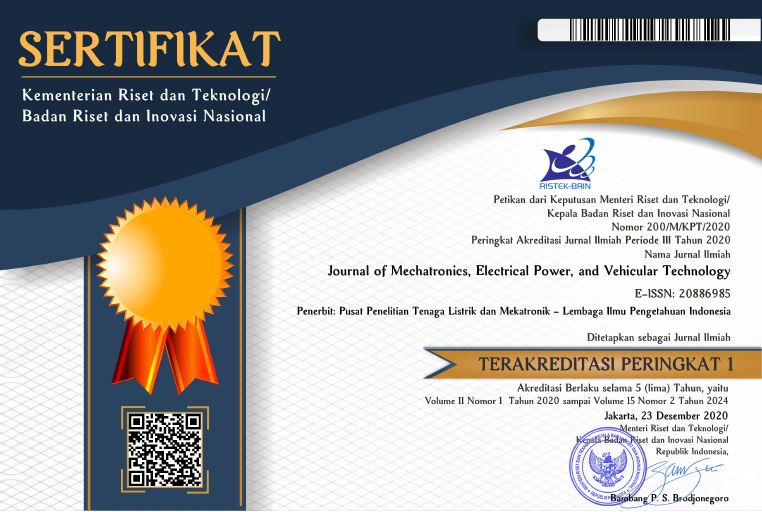Study on the transient response of lower limb rehabilitation actuator using the pneumatic cylinder
Abstract
A lower limb rehabilitation device was designed using the compressed air cylinder in order to answer the particular request in Vietnam. This paper is presenting the results of a study of the device response. Dynamic equation of the actuator and equations of the proportional valve have been established. The relationship between the input signal and the output signal of the actuator was derived. Inventor® software was used to design the mechanical structure of the device. Matlab® software was used to calculate the parameters values of the PID controller by simulating the response of the actuator. The results show that the response time of both knee drive and hip drive mechanisms are 8 seconds while the overshoot of both knee drive and hip drive mechanisms are 1%. Moreover, the starting torque of the knee drive mechanism is 17 Nm, and the starting torque of the hip drive mechanism is 35 Nm. The simulation results show that the PID controller gives a fast response time and a low overshoot.
Keywords
Full Text:
PDFReferences
G.Z Xu, A.G. Song, and H.J. Li, “System design and control technique of robot aided rehabilitation,” Journal of Clinical rehabilitation Tissue Engineering Research, vol. 13, pape 714-717, 2009. online
Z. Li, D. Guiraud, D. Andreu, A. Gelis, C. Fattal, and M. Hayashibe, “Real-Time closed-loop functional electrical stimulation control of muscle activation with evoked electromyography feedback for spinal cord injured patients,” International Journal of Neural Systems, vol. 28, no. 06, p.1750063, Aug. 2018. crossref
M. O. Ibitoye, N. A. Hamzaid, M. Hayashibe, N. Hasnan, and G. M. Davis, “Restoring prolonged standing via functional electrical stimulation after spinal cord injury: A systematic
review of control strategies,” Biomedical Signal Processing and Control, vol. 49, pp. 34–47, Mar. 2019. crossref
Y. Chen, J. Hu, W. Wang, L. Peng, L. Peng, and Z.-G. Hou, “An FES-assisted training strategy combined with impedance control for a lower limb rehabilitation robot,” in Proceeding of 2013 IEEE International Conference on Robotics and Biomimetics (ROBIO), 2013, pp. 2037–2042. crossref
P. Coenen, G. Werven, M. Nunen, J. Dieën, K. Gerrits, and T. Janssen, “Robot-assisted walking vs overground walking in stroke patients: An evaluation of muscle activity,” Journal of Rehabilitation Medicine, vol. 44, no. 4, pp. 331–337, 2012. crossref
H. Wang, D. Zhang, H. Lu, Y. Feng, P. Xu, R.-V. Mihai, and L. Vladareanu, “Active training research of a lower limb rehabilitation robot based on constrained trajectory,” in Proceeding of 2015 International Conference on Advanced Mechatronic Systems (ICAMechS), 2015, pp. 24–29. crossref
T. Khoo and S. Senanayake, “Intelligent Musculosoccer Simulator,” in The Impact of Technology on Sport II, Taylor & Francis, 2007. crossref
F. Molteni, G. Gasperini, G. Cannaviello, and E. Guanziroli, “Exoskeleton and end-effector robots for upper and lower limbs rehabilitation: Narrative review,” PM&R, vol. 10, no. 9, pp. S174–S188, Sep. 2018. crossref
R. R. Torrealba, S. B. Udelman, and E. D. Fonseca-Rojas, “Design of variable impedance actuator for knee joint of a portable human gait rehabilitation exoskeleton,” Mechanism and Machine Theory, vol. 116, pp. 248–261, Oct. 2017. crossref
G. Chen, P. Qi, Z. Guo, and H. Yu, “Mechanical design and evaluation of a compact portable knee–ankle–foot robot for gait rehabilitation,” Mechanism and Machine Theory, vol. 103, pp. 51–64, Sep. 2016. crossref
J. F. Veneman, R. Kruidhof, E. E. G. Hekman, R. Ekkelenkamp, E. H. F. Van Asseldonk, and H. van der Kooij, “Design and evaluation of the LOPES exoskeleton robot for interactive gait rehabilitation,” IEEE Transactions on Neural Systems and Rehabilitation Engineering, vol. 15, no. 3, pp. 379–386, Sep. 2007. crossref
C. L. Lynch and M. R. Popovic, “A Comparison of closed-loop control algorithms for regulating electrically stimulated knee movements in individuals with spinal cord injury,” IEEE Transactions on Neural Systems and Rehabilitation Engineering, vol. 20, no. 4, pp. 539 548, July 2012. crossref
H. Yu, M. S. Cruz, Gong Chen, Sunan Huang, C. Zhu, E. Chew, Yee Sien Ng, and N. V. Thakor, “Mechanical design of a portable knee-ankle-foot robot,” in 2013 Proceeding of IEEE International Conference on Robotics and Automation, 2013, pp. 2183–2188. crossref
S. Liu and J. E. Bobrow, “An analysis of a pneumatic servo system and its application to a computer-controlled robot,” Journal of Dynamic Systems, Measurement, and Control, vol. 110, no. 3, p. 228, 1988. crossref
H. S. Nam, S. Koh, Y. J. Kim, J. Beom, W. H. Lee, S.-U. Lee, and S. Kim, “Biomechanical reactions of exoskeleton neurorehabilitation robots in spastic elbows and wrists,” IEEE Transactions on Neural Systems and Rehabilitation Engineering, vol. 25, no. 11, pp. 2196–2203, Nov. 2017. crossref
Article Metrics
Metrics powered by PLOS ALM
Refbacks
- There are currently no refbacks.
Copyright (c) 2018 Journal of Mechatronics, Electrical Power, and Vehicular Technology

This work is licensed under a Creative Commons Attribution-NonCommercial-ShareAlike 4.0 International License.




















